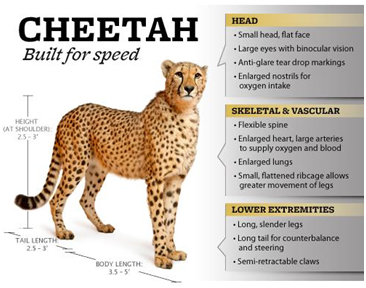Cheetah
Context: The introduction of African cheetahs to India was planned without considering their spatial ecology, according to researchers who warn that the released animals may come into conflict with people in the neighbouring villages.
More on the News
- A total of 20 cheetahs from Namibia and South Africa were introduced to Kuno National Park in Madhya Pradesh last year to establish a free-ranging population—for the first time since their extinction in India 70 years ago.
- Scientists of the Cheetah Research Project of Leibniz-IZW in Namibia argue that in southern Africa, cheetahs live in a stable socio-spatial system with widely spread territories and densities of less than one individual per 100 square kilometres (km²).
- The plan for cheetahs in Kuno National Park assumes that the high prey density will sustain high cheetah densities, even though there is no evidence for that, the scientist claimed.
- Researchers noted that as Kuno National Park is small, it is likely that the released animals will move far beyond the park’s boundaries and cause conflicts with neighbouring villages.
- Kuno National Park is an unfenced wilderness area of approximately 17 by 44 kilometers (about 750 km²).
- Based on a calculation of the local prey density, it was calculated that 21 adult cheetahs could be sustained by the prey base in Kuno National Park—equivalent to a density of about three individuals per 100 km².
About Cheetah
- The cheetah is a prominent cat family member that belongs to the subfamily Felinae and is found across Africa and some parts of Iran.
- The cheetah prefers grassland habitats where it has enough space to go after its prey without any obstacles.
- Widely regarded as the fastest animal on land, cheetahs are divided into four subspecies; the Southeast African cheetah, the Northeast African cheetah, the Northwest African cheetah, and the rare Asiatic cheetah.
- The Asiatic cheetah is slightly smaller and slender than the African cheetah. Their legs are also slender, which has led many to believe that they could be much faster than their African cousins.
- The African cheetah has a light brown to golden brown fur color that is thicker than the Asiatic ones.
- The Asiatic cheetah is placed in the critically endangered category, and the African cheetah is vulnerable under the IUCN Red List.
| Practice Question
1. How cheetah reintroduction will help the overall wildlife conservation in India? |




